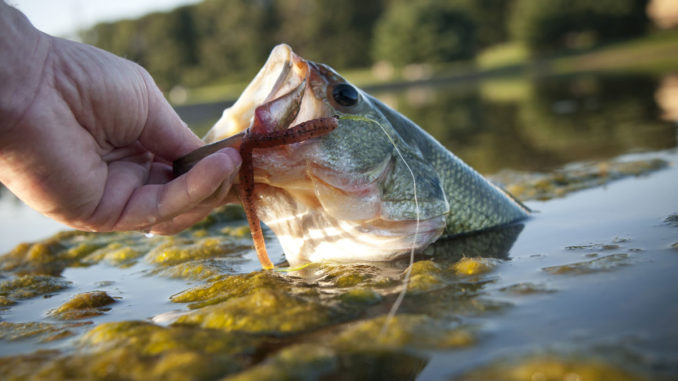
Bass are hungry, hitting anything, anywhere
June has always been one of my favorite months to fish for bass in North Carolina, and not just because there’s usually a great crankbait bite. It’s a time when no matter how you like to fish, you can catch fish that way, and almost anywhere you go. You can catch fish shallow, at mid-depths and deeper. You can catch fish on topwater in the mornings, on soft-plastic baits, on spinnerbaits, on crankbaits. Nobody has a big advantage; it’s just a matter of what stage the bigger fish are in.
This year, I don’t know what to think, because of the really strange weather we had this past winter and this spring are lining up to make this June a very unusual one. Everything appears to be running late, maybe two weeks late. We’ve had a late, late spawn. I think a lot of fish spawned on the full moon and new moon in May, but I think we’re going to have some fish spawning in June the way we’re going. That will make for some really interesting choices for fishermen.
Here’s how I’m going to approach things. I’m going to be very aware of how the weather was the week before I get out on the lake, and not just what the water temperature is that morning. I want to go in with an idea of what stage the fish are in. Are some of them still spawning? Are a lot of them in that post-spawn funk where they’re suspended and not biting? Have a good number of them retreated to those little secondary points and corners — the first places that fish go when they have come out of the post-spawn and are hungry? Are they schooled up?
If I can answer that question, then I’m a long ways toward getting on them and knowing what to throw and where to throw it.
June has always been a great month to fish a topwater bait in our lakes, especially in early June, and I think there will still be a good topwater bite; it just might be later. But no matter what you do, a Zara Spook will be a good bait. I like to throw it on a 7-foot or 7-foot-6 Lew’s flipping stick. You need that longer rod because you need to make long casts; they always seem to blow up where you can barely reach them. You also need that flipping stick to be able to make those hooksets at a distance.
One thing you need to establish is whether they want the bait retrieved real fast — where you have to keep your rod tip moving constantly — or whether they want to you to walk it more slowly and real wide. Your rod choice also depends on how you work the bait. It you work the bait by keeping your rod tip going up and down, the shorter, 7-foot rod is better. If you work it by moving your rod tip from side to side, the longer rod will be better.
When I leave the dock in June, I’m probably going to have on my casting deck a couple of rods rigged with crankbaits that will run eight to 12 feet deep, a couple of rods rigged with crankbaits that will run 12 to 15 feet deep, a rod with a Zara Spook, and a rod with a big Berkley Power Worm that’s Texas-rigged.
I’ll be looking for fish that have spawned earlier and moved out. That’s when you find your big groups of fish, and June is known as a month when bass school, when they get in big groups. I always look and try to find the first place that bass will stop when they leave the coves where they’ve spawned. That’s usually some kind of place where it drops from eight to 10 feet deep. The like to come out and get on those little creek-channel ledges, those little drops. I like to spend my time finding those kinds of places and fishing them with a medium-running crankbait. Shad colors dominate at this time of year: blue/pearl, green/pearl, gray shad with a black back — colors like that. And they tend to like a crankbait that makes a lot of noise and has a wide wobble, like a Norman Little N or one of Strike King’s XPS baits. They are very aggressive this month, and they like those wide-wobbling baits or baits with rattles.
I think electronics can make a big difference anytime fish get out on submerged structure. The Raymarine unit I’ve got on the bow of my boat, if I’m over 10 feet of water, I can see out 10 feet ahead of me; if I’m over 15 feet, I can see out 15 feet. That can make a huge difference when you’re looking for fish on a drop or a ledge. I don’t have a need for any side-imaging; my unit does a real good job of showing fish that are right on the bottom; sometimes, you can actually see the head and tail of the fish.
A couple of things bear mentioning. What fish are doing at Lake Wylie, on the South Carolina border, can be as much as two or three weeks ahead of what’s going on at a place like Buggs Island or Gaston, on the Virginia border. I think we’ll have a good chance to catch spawning fish on those lakes in June.
At Wylie, fish are already going to be out on ridges and drops. At High Rock, they’re obviously going to be shallow, around docks. At Buggs Island and Gaston, they might be just coming off the beds or still on them.
No matter where they are, June is a month when you can catch fish if just pay attention to a few things, because they’re going to want to bite.




Be the first to comment